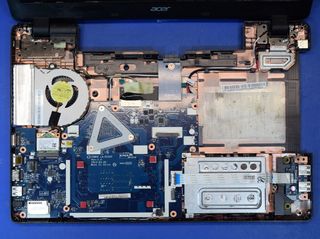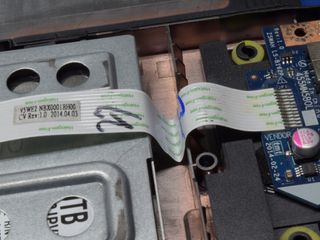Repairing an Acer E5-521 Laptop: A Case Study
Opening The Patient Up For Diagnosis
A handful of screws, some prying, and a few ribbon cable disconnections later, the keyboard and trackpad lift off from the chassis, exposing the motherboard and other internal components.

My worries about hinge damage affecting the motherboard turned out to be completely unfounded; the circuit board comes nowhere close to either corner. There's no risk of a broken DC-in jack board connection either as it is connected to the board using jumper wires, a necessity given its location in the opposite chassis corner from the mainboard. Another consequence of the board being so small is that it does not reach the battery bay either, and an additional bridge board running vertically near the middle is used to make the connection.
I wasn’t expecting the insides to look practically factory-clean from how rough the fall repairs looked. Then again, it is entirely possible that whoever put it back together after surgery gave it a good clean along the way.
The laptop’s layout is typical of contemporary models using processors with integrated graphics: the motherboard occupies the front-left corner, heat pipes carry waste heat from the CPU to the left edge’s fin stack where a thin blower fan shoves air through it and out the left side. Along the right edge, starting from the front, we find the laptop’s 1TB Western Digital disk drive buried under the right-hand USB ports’ ribbon cable, the unpopulated optical drive bay, and the DC-in jack. Most of the internal chassis surface has been copper-coated to mitigate electromagnetic interference, except for the optical bay area where the copper appears to also have been plated with tin, zinc, or nickel.

Acer may be reusing the same USB board across different laptop models. Instead of maintaining inventory of the same board with different model-specific flat-flex cables (FFC) attached, it picked a one-size-fits-all approach where excess length is simply tucked into the space behind the storage device, or wherever else may be convenient in other models.


From the top, the only sign of damage I found, structural or otherwise, was a suspiciously large hole with a rough edge in the battery latch mechanism area. After sifting through the fallen bits and pieces, I found a broken screw well and its corresponding hole on the keyboard’s back. This failure pattern leaves me scratching my head: if something had fallen on the keyboard, I would have expected the support to get punched through out of the case. Here though, the break is on the inside, as if someone tried to rip the keyboard off. Did the first repair person forget to remove this screw before attempting to pry the keyboard off? The only other way I can imagine causing this type of failure would be repeated stress on either side of the support but such material fatigue would involve some seriously heavy keyboard pounding.
With the tour of general layout and obvious physical damage taken care of, let’s have our first serious look at the motherboard.
Stay on the Cutting Edge
Join the experts who read Tom's Hardware for the inside track on enthusiast PC tech news — and have for over 25 years. We'll send breaking news and in-depth reviews of CPUs, GPUs, AI, maker hardware and more straight to your inbox.

On the top side of the board, we find the power management circuitry responsible for handling external and battery power, the CPU’s core voltage regulator, a handful of additional voltage regulators responsible for generating the support rails (memory voltage and 5V/12V for the SATA and optical drives), the CPU hidden under its heat pipe mount, two DIMM slots, and the real-time clock backup battery.
With so few major components on the board, there isn’t a whole lot to troubleshoot before entering lost cause territory. Since we appear to have no power whatsoever, a logical starting point would be capacitors across the system (battery/external) power rail if we can find an obvious suspect to begin probing from. We know the external adapter provides 19V, so we’re looking for a capacitor rated for 25V or higher if we are lucky enough to have one in metal can format with markings on it (instead of multi-layer chip capacitor, which typically have no markings whatsoever).
MORE: Best Gaming Laptops
MORE: Gaming Laptop Previews
MORE: All Laptop Content
Current page: Opening The Patient Up For Diagnosis
Prev Page Meet Our Acer E5-521, Dead On Arrival Next Page On The Hunt-
Roland Of Gilead Ha, that was interesting!Reply
At first I thought, 'what the heck is this about?'. Thought the title alone was very random. Anyway, I read the article and it's changed my mind. Not only is it well written, but also informative. I've had maybe, three laptops that I've either thrown away or given away, some with minor issues that I couldn't have been bothered to try and troubleshoot. Screens failing, other unusual behaviour with power issues etc. I guess Ill brush up on some basic engineering skills, and give future dead devices a chance for redemption.
Thanks Daniel, I enjoyed that of a Sunday morning :) -
farberj Nice and informative article, nice to see the logical train of thought that a true problem solver uses.Reply -
Danny Leiva Thanks for the very informative piece! About 6 months ago I repaired my wife's macbook air after there was a spill accident that occurred. With resources online, I figured out and was able to diagnose that the connector on the board with the ribbon cable to LCD had a few pins that had disintegrated. Was able to buy the replacement connector online and, after learning to get much better with tiny-piece soldering, was able to replace the connector successfully! Felt really good!Reply -
AnimeMania The real question is how much information was retrievable from the hard drive. Name, address, phone number, SSN#, (amazon, facebook, twitter and banking access), personal photos (some of a very private nature (nude)), tax returns, emails, etc. What are your legal rights to this information, is it similar to when someone buys one of those abandoned storage lockers contents? Anyone with minimal computer skills could probably remove the hard drive and revue its contents.Reply -
Allen_B Great article, thanks! I've got some electronics knowledge but this is inspiration to learn more. It's such a shame to see electronics end up in the trash, and friends having to shell out for new stuff they didn't really need.Reply -
Daniel Sauvageau Reply20251438 said:Ha, that was interesting!
Thanks Daniel, I enjoyed that of a Sunday morning :)
Glad you liked it!20251813 said:Nice and informative article, nice to see the logical train of thought that a true problem solver uses.
Liquid damage can get pretty nasty when power stays on long enough to let electrolysis eat the pads. Congrats on managing to replace the connector!20251834 said:Thanks for the very informative piece! About 6 months ago I repaired my wife's macbook air after there was a spill accident that occurred.
The HDD is fully operational, whatever information on it that wasn't encrypted would have been easy picking. When my friend told me that I could keep the laptop when I couldn't repair the keyboard, I did a factory reset to get rid of the password instead of poking around for ways to crack it.20251991 said:The real question is how much information was retrievable from the hard drive. -
mikewinddale "support your 'Right to Repair' and similar bills"Reply
But that just means that devices will be more expensive. Presumably, devices are being constructed with more proprietary parts that are difficult to repair, because this makes the final product less expensive for the consumer. (After all, manufacturers compete with each other, and it is difficult to imagine them deliberately making their products more expensive than necessary.)
Furthermore, as standards-of-living increase, wages tend to increase relative to raw material and other manufacturing costs. This rise in relative wages means that it is economically less sensible to repair broken devices. When wages are low and manufacturing costs are high, it makes sense to pay a repairman to avoid purchasing a replacement. But when wages are high and manufacturing costs are low, it makes more sense to trash the device and buy a new one.
So a "right to repair" would essentially mean increasing manufacturing costs without any benefit. The device would cost more to purchase, and in the end, high labor costs mean it wouldn't be worth it to repair it anyway, so you'd still end up buying a new device when it breaks. So you're paying more to purchase a repairable device, and even then, it still isn't worth it to repair. -
IInuyasha74 Certainly was an interesting read. Must feel like a big waste of time for a beat up old laptop with an AMD E2 processor in it, but excellent for the fun of seeing a notebook taken apart and parts soldered on and off of it.Reply
Most Popular



